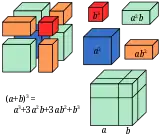Computational number theory
In mathematics and computer science, computational number theory, also known as algorithmic number theory, is the study of computational methods for investigating and solving problems in number theory and arithmetic geometry, including algorithms for primality testing and integer factorization, finding solutions to diophantine equations, and explicit methods in arithmetic geometry.[1] Computational number theory has applications to cryptography, including RSA, elliptic curve cryptography and post-quantum cryptography, and is used to investigate conjectures and open problems in number theory, including the Riemann hypothesis, the Birch and Swinnerton-Dyer conjecture, the ABC conjecture, the modularity conjecture, the Sato-Tate conjecture, and explicit aspects of the Langlands program.[1][2][3]
Software packages
Further reading
- Eric Bach; Jeffrey Shallit (1996). Algorithmic Number Theory, Volume 1: Efficient Algorithms. MIT Press. ISBN 0-262-02405-5.
- David M. Bressoud (1989). Factorisation and Primality Testing. Springer-Verlag. ISBN 0-387-97040-1.
- Joe P. Buhler; Peter Stevenhagen, eds. (2008). Algorithmic Number Theory: Lattices, Number Fields, Curves and Cryptography. MSRI Publications. 44. Cambridge University Press. ISBN 978-0-521-20833-8. Zbl 1154.11002.
- Henri Cohen (1993). A Course In Computational Algebraic Number Theory. Graduate Texts in Mathematics. 138. Springer-Verlag. doi:10.1007/978-3-662-02945-9. ISBN 0-387-55640-0.
- Henri Cohen (2000). Advanced Topics in Computational Number Theory. Graduate Texts in Mathematics. 193. Springer-Verlag. doi:10.1007/978-1-4419-8489-0. ISBN 0-387-98727-4.
- Henri Cohen (2007). Number Theory – Volume I: Tools and Diophantine Equations. Graduate Texts in Mathematics. 239. Springer-Verlag. doi:10.1007/978-0-387-49923-9. ISBN 978-0-387-49922-2.
- Henri Cohen (2007). Number Theory – Volume II: Analytic and Modern Tools. Graduate Texts in Mathematics. 240. Springer-Verlag. doi:10.1007/978-0-387-49894-2. ISBN 978-0-387-49893-5.
- Richard Crandall; Carl Pomerance (2001). Prime Numbers: A Computational Perspective. Springer-Verlag. doi:10.1007/978-1-4684-9316-0. ISBN 0-387-94777-9.
- Hans Riesel (1994). Prime Numbers and Computer Methods for Factorization. Progress in Mathematics. 126 (second ed.). Birkhäuser. ISBN 0-8176-3743-5. Zbl 0821.11001.
- Victor Shoup (2012). A Computational Introduction to Number Theory and Algebra. Cambridge University Press. doi:10.1017/CBO9781139165464. ISBN 9781139165464.
- Samuel S. Wagstaff, Jr. (2013). The Joy of Factoring. American Mathematical Society. ISBN 978-1-4704-1048-3.
References
- Carl Pomerance (2009), Timothy Gowers (ed.), "Computational Number Theory" (PDF), The Princeton Companion to Mathematics, Princeton University Press
- Eric Bach; Jeffrey Shallit (1996). Algorithmic Number Theory, Volume 1: Efficient Algorithms. MIT Press. ISBN 0-262-02405-5.
- Henri Cohen (1993). A Course In Computational Algebraic Number Theory. Graduate Texts in Mathematics. 138. Springer-Verlag. doi:10.1007/978-3-662-02945-9. ISBN 0-387-55640-0.
External links
 Media related to Computational number theory at Wikimedia Commons
Media related to Computational number theory at Wikimedia Commons
